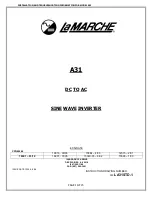
LC2000/LC2000-IQ/LC4000/LC4000-IQ
System Setup Menus
Issue 1 Rev 6
Page 36
© 2015 SAM
7.2.1 CVBS Decoder A and B – CT2 Configuration
Each slot has two composite video connections.
•
Source:
Use to select a video input source. If using a composite source, only one of
the two CVBS connectors are used.
•
Input 1:
Connection A1 (or B1) contains the input composite signal.
•
Input 2:
Connection A2 (or B2) contains the input composite signal.
•
Y/C:
When using Y/C signals both composite connectors are used, so this option
must be selected.
•
ACC:
The Automatic Chroma Control (ACC) examines the input burst amplitude and
adjusts chrominance gain to compensate for chroma level attenuation.
Note: Use this control when chroma levels are low compared to luminance. This may
occur when using YC installations or composite from RF links
.
•
CTI:
The Chroma Transient Improver (CTI) examines the input video data. CTI
detects transitions of chroma and enhances chroma edges in order to artificially
restore lost color bandwidth.
Note: Use this control when the input video has chroma bandwidth limitations.
•
Pedestal:
When turned on, allows the composite source (NTSC only) to be treated as
if a pedestal is present.
•
NTSC Hue:
Adjusts the NTSC hue to correct tonal color changes.
7.2.2 CVBS Decoder A, B, C, D – CD4 Configuration
Each slot is available as a composite decoder.
•
Source:
Use to select a video input source. If using a composite source, only one of
the two CVBS connectors are used.
•
Input 1:
Connection A1, B1, C1, or D1 contains the input composite signal.
•
Input 2:
Connection A2, B2, C2, or D2 contains the input composite signal.
All other controls are the same as the Section 7.2.1 CVBS Decoder A and B – CT2
Configuration controls.
Note:
The unit automatically detects the input standard.
















































